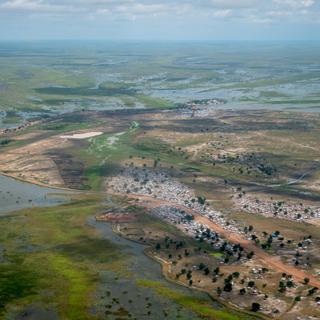


The relentless struggle of South Sudanese displaced by war and endless flooding
NewsSince 2021, unprecedented flooding has engulfed Bentiu, the capital of Unity State and the surrounding area. Villages, forests, farmland and animal herds were submerged in a matter of days. The water never completely receded.
Ripples splashed against the seawall where Kunen Ganor stood. In front of the frail 34-year-old, the water stretched as far as the eye could see. "Here, there was a forest, a very big forest," said the representative of displaced persons from the camp adjoining the UN base in Bentiu, in the north of South Sudan, where he has lived for the past 10 years. Canoes sailed between the withered trees, while fishermen, immersed up to their shoulders, attached their nets to floats cobbled together from plastic bottles. According to Ganor, since the beginning of the year, 17 children have drowned while venturing into the water in search of food.
This ongoing struggle for survival began in August 2021, when Bentiu, the capital of Unity State, and the surrounding area were hit by unprecedented flooding. Villages, forests, farmland and herds were engulfed in a matter of days. Since then, the water has never really receded, covering almost 5,600 km2 with stagnant pools one to two meters deep.
One of the five countries in the world most vulnerable to climate change according to the UN, South Sudan has been facing repeated flooding for the past four years. Torrential rains and rising water levels in the Lake Victoria basin have caused the Sudd, a huge swampy area stretching 30,000 km2 to 90,000 km2 depending on the season, to overflow into the floodplain of the White Nile and its tributaries. "The amount of permanently flooded area has tripled," said Bill Nall, a World Food Program (WFP) expert in charge of flood research and monitoring. "Today, 12 to 15% of South Sudan's surface is flooded, as opposed to 5% previously."


A paradox of climate change, these floods are coupled with increasingly devastating periods of drought. Indeed, South Sudan is experiencing a warming trend two and a half times greater than the global average variation in air temperature. It has also seen a 10% to 20% drop in rainfall since the mid-1970s, but this is becoming more unpredictable and inconsistent in volume.
These concomitant phenomena have deprived millions of South Sudanese of their livelihood and exacerbated hunger in the world's youngest country. According to the WFP, 7.7 million of South Sudan's 12 million inhabitants have "severe food insecurity," at a time when funding for humanitarian organizations is well below requirements due in particular to the war in Ukraine and the conflict that began in Sudan in mid-April.
Water pollution
In Unity State, the crises have "displaced almost half the population," according to John Juan Buom, director of the regional government's humanitarian commission. In all, no fewer than 230,000 people live in Bentiu, next to the base of the United Nations Mission in South Sudan (UNMISS): 100,000 who fled the civil war in 2013 settled in the camp; another 80,000 who were driven from their homes by the floods; and another 50,000 who have sought refuge from the war in Sudan since mid-April.
You have 75% of this article left to read. The rest is for subscribers only.
